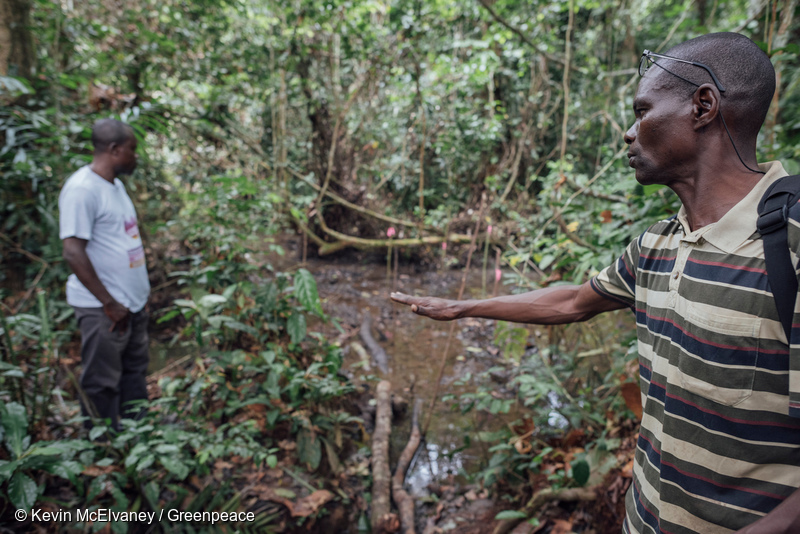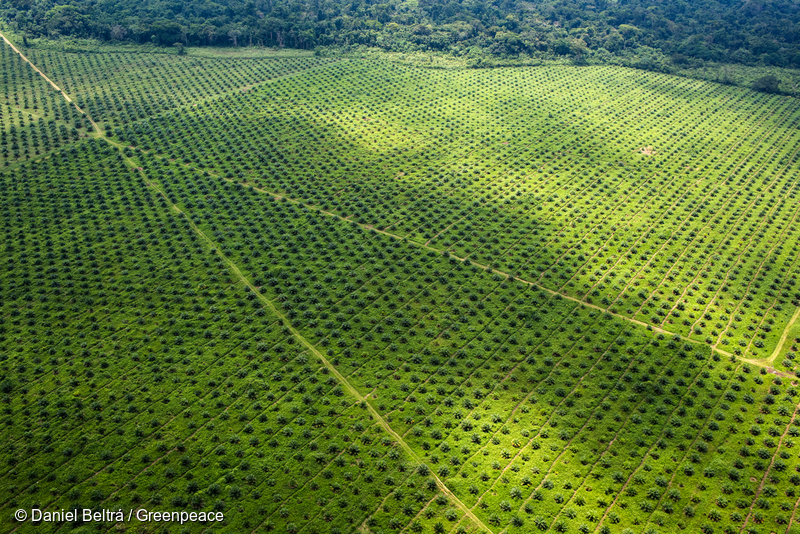This is the wrap-up article for our four-part series “The Congo Basin peatlands.” Read Part One, Part Two, Part Three and Part Four.
In the first half of December, Mongabay published a four-part series on the peatlands of the Congo Basin. Only in 2017 did a team of Congolese and British scientists discover that a sprawling wetland known as the Cuvette Centrale spanning the border between the Republic of Congo and the Democratic Republic of Congo (DRC) actually contains a massive amount of peat. Their satellite mapping and ground truthing revealed that these peatlands cover an area the size of England and are the largest and most intact across the world’s tropics.
But how did they get there? Why are they so important? And what does the future hold for the peatlands of the Congo Basin?
Our series probes these questions and more in detail, tapping into the ongoing research and surveying the threats that could disrupt, degrade or even destroy this unique ecosystem. Here are 10 takeaways from our reporting.
Aerial view of the Monboyo River and peatland forest of Salonga National Park in the Democratic Republic of Congo (DRC). Image © Daniel Beltrá/Greenpeace.
1. The peatlands of the Congo Basin hold more than 30 billion metric tons of carbon.
For at least the last 10,000 years, bits of organic matter have been piling up in this part of Central Africa, layer upon layer. Water from surrounding streams and rivers and in the form of rainfall has continually swamped the soil, slowing to a crawl the decomposition that would normally occur in this part of the world’s second-largest rainforest. In the process, carbon that would have been released into the atmosphere has remained locked underground. As a result, the peatlands provide an unseen but critical benefit by preventing this carbon from further warming the global climate.
Researchers calculate that the peatlands contain around two-thirds as much carbon as the aboveground trees in the entire Congo rainforest on only about 4% of the land area. That 30 billion metric tons is roughly the same amount of carbon released by the global economy in three years.
2. The Cuvette Centrale peatlands are also home to human communities.
People have been living in and around the peatlands for centuries. They rely on these wetland forests for wood, medicine and food from the fruits and fisheries found there, to name just a few of the resources provided by the peatlands. In spite of — or indeed, perhaps because of, in part — their use of the forest, these communities appear to have done little to degrade the peatlands thus far. They are considered the most intact in all the world’s tropics, and research is underway to understand how people in the area use them sustainably.
 Community members welcome the international expedition team. Image © Kevin McElvaney/Greenpeace.
Community members welcome the international expedition team. Image © Kevin McElvaney/Greenpeace.
3. Showstopping wildlife, along with diverse plant species, live in the peatlands.
The peatlands are remote and very difficult for humans to travel through. That’s made the area a refuge for a wondrous array of wildlife, many species of which are threatened. Forest elephants (Loxodonta cyclotis), chimpanzees (Pan troglodytes), bonobos (Pan paniscus) and western lowland gorillas (Gorilla gorilla gorilla) all lurk in the forests of the peatlands.
Surveys by University of Kisangani botanist Corneille Ewango and others have turned up a dizzying variety of plants as well. In just one section, Ewango and his colleagues found 110 species. “And we’re still finding more,” he says.
4. But industrial logging, agriculture and resource extraction could disrupt or degrade the Congo Basin peatlands.
As relatively pristine as they are, the peatlands also figure in the development plans for both the Republic of Congo and the DRC. Concessions for agriculture, logging or oil and gas cover 80% of the area of the peatlands, according to the environmental NGO Greenpeace.
 Corneille Ewango of the University of Kisangani in the DRC explains how to navigate through the peatlands. Image © Kevin McElvaney /Greenpeace.
Corneille Ewango of the University of Kisangani in the DRC explains how to navigate through the peatlands. Image © Kevin McElvaney /Greenpeace.
5. The prospect of oil could prove an enticing avenue for boosting the economies of the Republic of Congo and the DRC.
Research in 2019 suggested that the peatlands might rest atop a huge pool of oil. Today, it’s still unclear just how much, but international oil companies and consulting firms are exploring for the presence of hydrocarbons deep below the surface. Some suggest that extracting the oil may be possible with little disruption to the peatlands by using techniques commonly associated with offshore drilling. But the danger to the peatlands posed by the prospect of oil spills is an open question, and the construction of roads required to truck oil out from the peatlands can cause widespread damage to the wetland forests.
6. Industrial logging and agriculture plantations could spell disaster for the peatlands.
As Southeast Asia has become saturated with oil palm especially, but also industrial cash crops such as rubber, producers have turned their attention to Africa and other parts of the tropics for new lands to cultivate. But clearing the forest and draining the peatlands of water to grow oil palm would be unwise, scientists say. Large areas of peat have been turned over to industrial agriculture in Indonesia, and they now add climate-warming carbon to the atmosphere instead of being a secure repository for it. The practice has also destroyed the complex ecosystems that peatlands support.
 Aerial view of a palm oil plantation in the DRC. Image © Daniel Beltrá/Greenpeace.
Aerial view of a palm oil plantation in the DRC. Image © Daniel Beltrá/Greenpeace.
7. The 2018 signing of the Brazzaville Declaration, calling for international collaboration to protect tropical peatlands, between Indonesia, the Republic of Congo and the DRC buoyed the optimism of many scientists and conservationists.
The agreement has paved the way for the two Congos to protect the Cuvette Centrale peatlands before they are degraded or destroyed. Lessons from Indonesia demonstrate that it is far easier to protect the peatlands and the carbon they contain than it is to restore the full wetland-anchored ecosystem, a process that can take hundreds to thousands of years. Still, there are benefits to rewetting former peatland areas, including halting the release of CO2 into the atmosphere.
The three countries, along with Peru, have formed the Global Peatlands Initiative to further provide support for protection and restoration.
8. Leaders in the Republic of Congo and the DRC say they need further international support to protect the peatlands for the benefit of the world at large.
The United Nations and international NGOs are working to find ways to finance economic development while also encouraging countries like the Republic of Congo and the DRC to protect their forests and peatlands. Initiatives such as REDD+, short for reducing emissions from deforestation and forest degradation in developing countries, could provide a path toward bolstering the countries’ investments in education, employment and health care while keeping the forest standing and the peatlands intact.
Under such schemes, it is important to ensure that the communities that live in these areas benefit and that their land rights are secure, said Rainforest Foundation UK executive director Joe Eisen.
 A farmer prepares his field in the DRC. Image © Kevin McElvaney/Greenpeace.
A farmer prepares his field in the DRC. Image © Kevin McElvaney/Greenpeace.
9. Scientists aren’t sure how warming temperatures will affect the peatlands or what the broader consequences might be.
Scientists can’t yet fully predict the impact of climate change on the peatlands. On one hand, the rising CO2 levels responsible for global warming could boost plant growth and thus a primary organic input into the peat system. On the other hand, changing weather patterns could tip the balance the other way. Research has shown that the peatlands of the Congo Basin owe their existence in part to regional rainfall patterns. If climate change fiddles with the length of the rainy season, it could dry out the peatlands, pushing them toward becoming a net source of CO2.
10. Research on the peatlands continues, in the hopes that learning more about the ecosystem’s past will tell us something about its future.
A growing team of scientists continues to interrogate the inner workings of the peatlands from every angle. Some are looking at the ancient botanical history of the peatlands, identifying new species of plants preserved in core samples. Others are trying to construct models that mimic the dynamics of the peatlands and their impact on the global carbon budget that can then feed into broader climate models. And new sociological research recently began that aims to tease apart the relationship between humans and the peatlands. The end goal is to better understand the role that peatlands will play today and in the future, not just in the communities that live nearby, but on the global scale.
To learn more about the research project, follow the researchers in real time on Twitter at @CongoPeat.
Banner image: A group of officials from the Republic of Congo, the DRC, the United Nations Environment Programme and the U.N.’s Food and Agriculture Organization conducted a review of peatland restoration in 2018. Image by Ricky Martin/CIFOR via Flickr (CC BY-NC-ND 2.0).
John Cannon is a staff features writer with Mongabay. Find him on Twitter: @johnccannon
Citation:
Dargie, G. C., Lewis, S. L., Lawson, I. T., Mitchard, E. T., Page, S. E., Bocko, Y. E., & Ifo, S. A. (2017). Age, extent and carbon storage of the central Congo Basin peatland complex. Nature, 542(7639), 86-90. doi:10.1038/nature21048
FEEDBACK: Use this form to send a message to the author of this post. If you want to post a public comment, you can do that at the bottom of the page.
Adaptation To Climate Change, Agriculture, Animals, Biodiversity, Carbon Conservation, Carbon Emissions, Carbon Finance, Carbon Offsets, Climate Change, Climate Change And Conservation, Climate Change And Forests, Climate Modeling, Climate Science, Community Forests, Conservation, Conservation Solutions, Earth Science, Ecology, Environment, Featured, Forest Carbon, Forests, Global Warming, Global Warming Mitigation, Haze, Impact Of Climate Change, Indigenous Peoples, Logging, Mammals, Oil, Oil Drilling, Old Growth Forests, Palm Oil, Parks, Peatlands, Primary Forests, Protected Areas, Rainforest Biodiversity, Rainforest Conservation, Rainforest People, Rainforests, Redd, Redd And Communities, Research, Rivers, Saving Rainforests, Science, Soil Carbon, Swamps, Threats To Rainforests, Tropical Conservation Science, Tropical Forests, Tropical Rivers, Wetlands
Africa, Central Africa, Congo, Congo Basin, Democratic Republic Of Congo, Drc, Equatorial Africa, Republic of Congo, Sub-Saharan Africa
Source link : https://news.mongabay.com/2021/12/the-past-present-and-future-of-the-congo-peatlands-10-takeaways-from-our-series/
Author :
Publish date : 2021-12-16 08:00:00
Copyright for syndicated content belongs to the linked Source.





